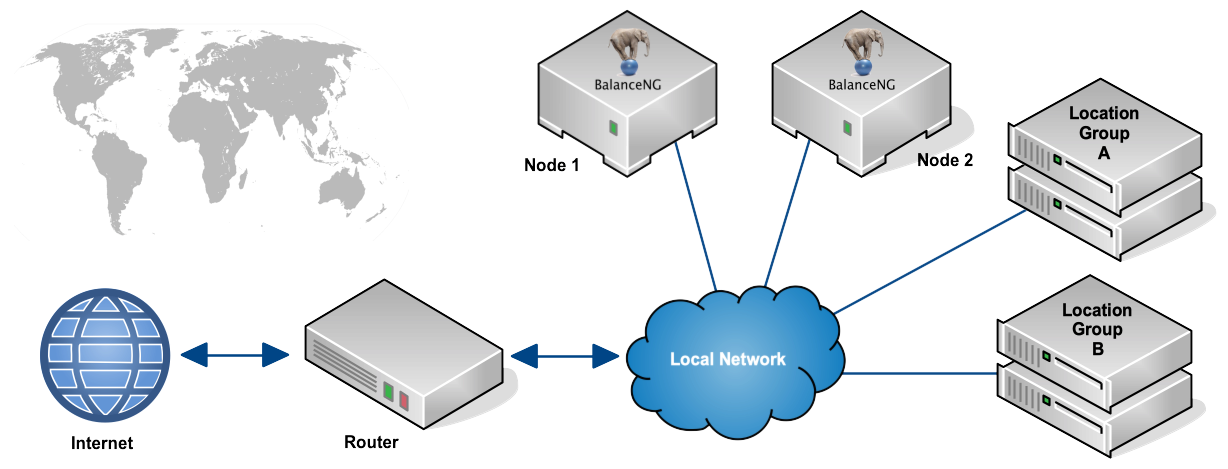8. Location-Based Load Balancing (IPDB/LGRP)
Overview

Location-Based Load Balancing Network Setup
This example is similar to example 5, but introduces the following new key concepts available with BalanceNG 2.160 and higher:
- Location-Based Load Balancing with the IPDB IP-to-location database
- Grouping of targets using “Location Groups” (LGRP)
First of all it’s needed to load a IP-to-Location database file into memory. This is done with the “ipdb” command loading the file from the default location:
ipdb "/opt/BalanceNG/IpToCountry.csv"
or, just include the following line at the top of /etc/bng.conf:
ipdb
BalanceNG supports the seven column format as available from software77.net (for IPv4/IPv6 upgrade instructions see this knowledge base article.
The five column format from WebHosting.info is no longer available.
Then, two “location groups” are defined: Group A containing the countries Germany, Austria and Switzerland and Group B containing everything else (including client IP addresses which are not found in the database). This is done by including the following lines in the BalanceNG configuration:
lgrp {
A "DE,AT,CH"
B "*,!A"
}
The server section needs to have “ipdb enable” included to enable the IPDB lookup mechanism like this:
server 1 {
ipaddr 172.16.1.10
targets 1,2,3,4
port 80,443
protocol tcp
ipdb enable
method agent
}
Please note that the ipdb lgrp feature does not work with the server methods “rr” (round-robin) and “hash”.
As the next step the targets need to be associated with the “location groups” defined earlier in the configuration file. This is done by including the directive “lgrp” in the target section.
In this example target 1 and two are member of lgrp A, and target 3 and 4 are member of lgrp B:
target 1 {
ipaddr 172.16.1.100
lgrp A
agent 439,2,5
script "/usr/lib/mon/mon.d/http.monitor -p $port$ -u /index.html $ipaddr$",2,7
dsr enable
}
target 2 {
ipaddr 172.16.1.101
lgrp A
agent 439,2,5
script "/usr/lib/mon/mon.d/http.monitor -p $port$ -u /index.html $ipaddr$",2,7
dsr enable
}
target 3 {
ipaddr 172.16.1.102
lgrp B
agent 439,2,5
script "/usr/lib/mon/mon.d/http.monitor -p $port$ -u /index.html $ipaddr$",2,7
dsr enable
}
target 4 {
ipaddr 172.16.1.103
lgrp B
agent 439,2,5
script "/usr/lib/mon/mon.d/http.monitor -p $port$ -u /index.html $ipaddr$",2,7
dsr enable
}
Informational Commands
The command “show ipdb” displays information about the currently loaded IP-to-location database:
NodeA# show ipdb IPDB loaded from /opt/BalanceNG/ip-to-country.csv 83429 valid 5-column lines 83429 total IPDB entries available no consecutive area overlaps 235 different IPDB locations referenced NodeA#
Another interesting feature is the ability to “locate” any IPv4 address using the locate command like this:
NodeA# locate 82.135.110.2 address 82.135.110.2 is in DE (GERMANY) NodeA#
The command “show locations” displays an overview of the current known locations in the IPDB database. Additionally, there’s a session counter maintained for each location (example output truncated):
NodeA# sh locations key counter description --- -------- ------------------------------------ AD ANDORRA AE 2 UNITED ARAB EMIRATES AF AFGHANISTAN ... CN 44 CHINA CO 9 COLOMBIA CR COSTA RICA CS 4 SERBIA AND MONTENEGRO CU CUBA CV CAPE VERDE CY 2 CYPRUS CZ 9 CZECH REPUBLIC DE 596 GERMANY DJ DJIBOUTI DK 23 DENMARK DM DOMINICA DO 8 DOMINICAN REPUBLIC ... UM UNITED STATES MINOR OUTLYING ISLANDS US 708 UNITED STATES UY 3 URUGUAY UZ 1 UZBEKISTAN VA HOLY SEE (VATICAN CITY STATE) VC SAINT VINCENT AND THE GRENADINES VE 8 VENEZUELA VG VIRGIN ISLANDS, BRITISH VI VIRGIN ISLANDS, U.S. VN 23 VIET NAM VU VANUATU WF WALLIS AND FUTUNA WS SAMOA YE YEMEN YT MAYOTTE ZA SOUTH AFRICA ZM ZAMBIA ZW ZIMBABWE - 30 *** NOT FOUND PSEUDO ENTRY *** --- -------- ------------------------------------ 235 2940 total
The command “clear locationcounters” resets all these counters back to 0.
Configuration Files
The configuration files in this example are ready for production use.
Node A
// configuration taken ...
// BalanceNG ...
hostname NodeA
remark "Location-Based Load Balancing with IPDB and LGRP"
interface eth0
vrrp {
vrid 9
priority 200
network 1
}
network 1 {
name "local network"
addr 172.16.1.0
mask 255.255.255.0
real 172.16.1.252
interface eth0
}
register network 1
enable network 1
ipdb "/opt/BalanceNG/ip-to-country.csv"
lgrp {
A "DE,AT,CH"
B "*,!A"
}
server 1 {
ipaddr 172.16.1.10
targets 1,2,3,4
port 80,443
protocol tcp
ipdb enable
method agent
}
register server 1
enable server 1
target 1 {
ipaddr 172.16.1.100
lgrp A
agent 439,2,5
script "/usr/lib/mon/mon.d/http.monitor -p $port$ -u /index.html $ipaddr$",2,7
dsr enable
}
target 2 {
ipaddr 172.16.1.101
lgrp A
agent 439,2,5
script "/usr/lib/mon/mon.d/http.monitor -p $port$ -u /index.html $ipaddr$",2,7
dsr enable
}
target 3 {
ipaddr 172.16.1.102
lgrp B
agent 439,2,5
script "/usr/lib/mon/mon.d/http.monitor -p $port$ -u /index.html $ipaddr$",2,7
dsr enable
}
target 4 {
ipaddr 172.16.1.103
lgrp B
agent 439,2,5
script "/usr/lib/mon/mon.d/http.monitor -p $port$ -u /index.html $ipaddr$",2,7
dsr enable
}
register targets 1,2,3,4
enable targets 1,2,3,4
// end of configuration
Node B
// configuration taken ...
// BalanceNG ...
hostname NodeB
remark "Location-Based Load Balancing with IPDB and LGRP"
interface eth0
vrrp {
vrid 9
priority 100
network 1
}
network 1 {
name "local network"
addr 172.16.1.0
mask 255.255.255.0
real 172.16.1.251
interface eth0
}
register network 1
enable network 1
ipdb "/opt/BalanceNG/ip-to-country.csv"
lgrp {
A "DE,AT,CH"
B "*,!A"
}
server 1 {
ipaddr 172.16.1.10
targets 1,2,3,4
port 80,443
protocol tcp
ipdb enable
method agent
}
register server 1
enable server 1
target 1 {
ipaddr 172.16.1.100
lgrp A
agent 439,2,5
script "/usr/lib/mon/mon.d/http.monitor -p $port$ -u /index.html $ipaddr$",2,7
dsr enable
}
target 2 {
ipaddr 172.16.1.101
lgrp A
agent 439,2,5
script "/usr/lib/mon/mon.d/http.monitor -p $port$ -u /index.html $ipaddr$",2,7
dsr enable
}
target 3 {
ipaddr 172.16.1.102
lgrp B
agent 439,2,5
script "/usr/lib/mon/mon.d/http.monitor -p $port$ -u /index.html $ipaddr$",2,7
dsr enable
}
target 4 {
ipaddr 172.16.1.103
lgrp B
agent 439,2,5
script "/usr/lib/mon/mon.d/http.monitor -p $port$ -u /index.html $ipaddr$",2,7
dsr enable
}
register targets 1,2,3,4
enable targets 1,2,3,4
// end of configuration